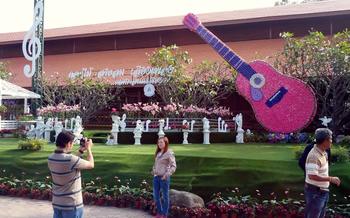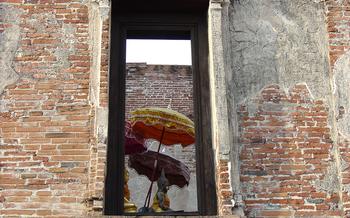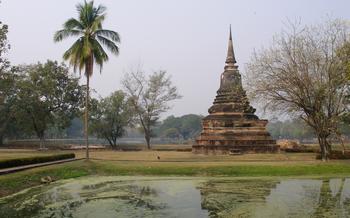
Wat Khanon Nang Yai Museum
- History of the Wat Khanon Nang Yai Museum
- Location and Accessibility
- Admission and Fees
- What to See and Do at the Museum
- Unique Features and Artwork
- Photography and Videography:
- Souvenirs and Shopping
- Local Cuisine and Dining
- Other Attractions Nearby
- Appropriate Attire and Behavior
- Accessibility for All
- Language Support and Translations
- Volunteer Opportunities
- Events and Workshops
- Insider Tip:
History of the Wat Khanon Nang Yai Museum
The Wat Khanon Nang Yai Museum is a treasure trove of Thai shadow puppetry, a traditional art form that has been captivating audiences for centuries. Founded in 1981 by Luang Por Udom, a revered monk and shadow puppet enthusiast, the museum is dedicated to preserving and promoting this unique cultural heritage.
Luang Por Udom, driven by his passion for shadow puppetry, embarked on a mission to collect and restore shadow puppets from various regions of Thailand. Through his tireless efforts, he amassed a vast collection of over 300 puppets, each intricately crafted and imbued with cultural significance.
The museum's primary purpose is to showcase the beauty and diversity of Thai shadow puppetry, while also educating visitors about its history, techniques, and cultural importance. It serves as a platform to revive and revitalize this ancient art form, ensuring its legacy continues to inspire future generations.
The Wat Khanon Nang Yai Museum stands as a testament to Luang Por Udom's dedication and vision. Its collection of shadow puppets provides a glimpse into the rich cultural tapestry of Thailand, offering visitors a unique and immersive experience that celebrates the artistry and storytelling power of this traditional art form.
Location and Accessibility
The Wat Khanon Nang Yai Museum is located at 44 Moo 4, Don Yai, Bang Phae, Ratchaburi 70180, Thailand. It is conveniently situated about 120 kilometers southwest of Bangkok, making it an accessible day trip destination. Visitors can opt for various transportation options to reach the museum.
For those traveling by car, the museum is easily accessible via the Phetkasem Road (Highway 4). Simply follow the signs for Ratchaburi and continue driving until you reach the museum's location. Ample parking space is available for visitors.
Public transportation is also a viable option. Take a bus from the Southern Bus Terminal in Bangkok bound for Ratchaburi. Once in Ratchaburi, take a local bus or taxi to reach the museum.
For a more scenic and immersive experience, consider traveling by train. Take a train from Hua Lamphong Station in Bangkok to Ratchaburi Railway Station. From the station, take a tuk-tuk or taxi to complete your journey to the museum.
Admission and Fees
Admission to the Wat Khanon Nang Yai Museum is free for both Thai and foreign visitors, making it an accessible and affordable attraction for everyone. The museum is open to the public daily from 8:00 AM to 4:00 PM, except for public holidays. Visitors are encouraged to plan their visit accordingly.
While admission is free, donations are gratefully accepted to support the museum's ongoing conservation efforts and educational programs. Donations help ensure the preservation and accessibility of this valuable cultural heritage for future generations.
There are no special discounts or concessions for students, seniors, or groups. However, the museum may offer occasional promotions or events with reduced admission fees or special activities. Visitors are advised to check the museum's official website or social media pages for up-to-date information on promotions and events.
Advance booking or reservations are not required to visit the museum. Visitors can simply arrive during the museum's operating hours and enjoy the exhibits at their leisure. The museum's staff is always happy to assist visitors with any questions or inquiries.
What to See and Do at the Museum
The Wat Khanon Nang Yai Museum boasts a remarkable collection of shadow puppets, each intricately crafted and imbued with cultural significance. Visitors can admire the delicate designs, intricate patterns, and vibrant colors that bring these puppets to life. The museum's interactive exhibits and displays provide an engaging and immersive experience, allowing visitors to delve deeper into the world of shadow puppetry.
Guided tours led by knowledgeable docents are available for those who want to gain a deeper understanding of the history, techniques, and symbolism behind these captivating works of art. The guides share fascinating stories and legends associated with the shadow puppets, bringing their cultural significance to life.
For a truly hands-on experience, visitors can participate in shadow puppet-making workshops, where they can learn the traditional techniques involved in creating these delicate works of art. This interactive activity allows visitors to connect with the art form on a personal level, creating their own unique shadow puppets to take home as cherished souvenirs.
Unique Features and Artwork
The Wat Khanon Nang Yai Museum houses a remarkable collection of shadow puppets that are not only visually stunning but also carry deep cultural significance. These puppets are handcrafted from intricately carved leather, each one telling its own story. The intricate designs and patterns on the puppets are a testament to the skill and artistry of their creators.
The museum's collection includes shadow puppets from various regions of Thailand, each with its own distinct artistic style. Some puppets are characterized by their bold colors and exaggerated features, while others are more delicate and intricate, with intricate details and patterns. The puppets depict a wide range of characters, from mythical creatures and deities to everyday people, allowing visitors to gain a glimpse into the rich mythology and folklore of Thailand.
Beyond their aesthetic appeal, the shadow puppets also hold cultural and historical significance. They have been used for centuries to tell stories, educate, and entertain audiences. The puppets often depict scenes from traditional Thai literature, such as the Ramayana and the Jataka tales, and serve as a means of preserving and transmitting cultural traditions from generation to generation.
In addition to the shadow puppets, the museum also displays a collection of related artifacts, such as puppet screens, musical instruments, and costumes. These artifacts provide visitors with a deeper understanding of the history and practice of shadow puppetry in Thailand.
Photography and Videography:
The Wat Khanon Nang Yai Museum welcomes visitors to capture the beauty and artistry of the shadow puppets through photography and videography. However, to ensure the preservation of the delicate artifacts and respect for the museum's environment, certain guidelines must be followed.
Visitors are permitted to take photos and videos for personal use, but flash photography is strictly prohibited to prevent damage to the puppets' intricate details. Tripods and other photography equipment are allowed, but visitors are requested to be mindful of other guests and avoid obstructing walkways or blocking exhibits.
When capturing videos, visitors should maintain a respectful distance from the shadow puppets and avoid disturbing other visitors' experiences. Live streaming or broadcasting of the museum's exhibits without prior permission is not permitted.
The museum encourages visitors to share their photos and videos on social media platforms, but tagging the museum and using relevant hashtags is appreciated to help spread awareness and promote the museum's mission.
Souvenirs and Shopping
The Wat Khanon Nang Yai Museum offers a unique opportunity to purchase souvenirs and handicrafts related to shadow puppetry. The museum shop sells a variety of items, including shadow puppets, masks, and other traditional Thai crafts. Prices range from a few dollars to several hundred dollars, depending on the size and intricacy of the item.
By purchasing a souvenir from the museum shop, visitors can not only take home a piece of Thai culture but also support local artisans and contribute to the community. The proceeds from the sale of souvenirs help to fund the museum's conservation efforts and educational programs.
Some of the most popular souvenirs include:
- Shadow puppets: Visitors can purchase shadow puppets in various sizes and designs, from small, handheld puppets to large, elaborate puppets that can be used for performances.
- Masks: The museum shop also sells a variety of masks, including traditional Thai masks used in dance and drama performances.
- Handicrafts: The museum shop sells various handicrafts, such as pottery, textiles, and wood carvings. These items are often made by local artisans using traditional techniques.
Local Cuisine and Dining
After immersing yourself in the world of shadow puppetry, take a culinary journey to savor the delectable flavors of Ratchaburi. Just a short walk from the Wat Khanon Nang Yai Museum, you'll find an array of local restaurants and food stalls tempting your taste buds.
Indulge in the aromatic delights of Ratchaburi's signature dish, "Khanom Jeen," a rice noodle dish served with a variety of flavorful curries. Choose from the spicy and tangy "Kaeng Daeng" (red curry), the creamy and aromatic "Kaeng Khiao Wan" (green curry), or the mild and sweet "Kaeng Phet" (duck curry).
For a truly authentic experience, try "Khao Soi Ratchaburi," a unique curry noodle dish made with egg noodles, tender chicken, and a rich, coconut-based curry sauce. The combination of flavors and textures is simply irresistible.
Vegetarians and vegans can rejoice in the abundance of delicious plant-based options available. Sample the flavorful "Pad Pak Bung Fai Daeng," a stir-fried morning glory with a hint of spiciness, or the refreshing "Som Tum," a spicy green papaya salad.
No meal in Ratchaburi is complete without "Roti Sai Mai," a crispy fried dough served with a sweet condensed milk dip. This popular dessert is a perfect way to end your culinary adventure on a sweet note.
As you savor the local delicacies, remember that each bite supports the local community and contributes to the preservation of Ratchaburi's rich culinary heritage. Embrace the vibrant flavors and aromas, and let the culinary delights of Ratchaburi linger in your memory long after your visit.
Other Attractions Nearby
The Wat Khanon Nang Yai Museum is located in the heart of Ratchaburi, a province rich in history, culture, and natural beauty. Take advantage of your visit to the museum by exploring other nearby attractions that will further enhance your understanding and appreciation of the region.
Just a short walk from the museum, you'll find the majestic Wat Mahathat Worawihan, a stunning temple complex known for its towering chedi and intricate murals. Continue your journey to the nearby Damnoen Saduak Floating Market, a vibrant and colorful spectacle where you can experience traditional Thai culture and indulge in delicious local cuisine.
If you're drawn to the natural wonders of Ratchaburi, head to the Khao Ngu Stone Park, where you can marvel at towering limestone karsts and explore hidden caves. Take a scenic boat trip along the Mae Klong River, passing lush greenery and traditional villages, or immerse yourself in the tranquility of the Suan Phueng Hot Springs, known for their therapeutic properties.
Whether you're interested in history, culture, nature, or adventure, Ratchaburi has something to offer every traveler. Make sure to allocate enough time to explore these nearby attractions and create a truly unforgettable experience in this captivating province.
Appropriate Attire and Behavior
When visiting the Wat Khanon Nang Yai Museum, it is important to dress respectfully, covering shoulders and knees. This is not only a sign of respect for the cultural significance of the museum but also helps create a contemplative atmosphere. Visitors should avoid wearing loud or disruptive clothing or accessories that may distract from the exhibits.
It is also important to maintain a quiet and respectful demeanor while exploring the museum. Whispering is encouraged, and visitors should refrain from talking loudly or engaging in disruptive behavior that may disturb other visitors or the museum staff. By following these guidelines, visitors can contribute to a positive and welcoming environment for all.
Accessibility for All
The Wat Khanon Nang Yai Museum welcomes visitors from all backgrounds and abilities. The museum is committed to providing a welcoming and accessible environment for everyone. The museum is wheelchair accessible, with ramps and elevators available for visitors with limited mobility. Visitors with special needs or requirements are encouraged to contact the museum in advance to make arrangements. The museum staff is happy to provide assistance to ensure that all visitors have a positive and enjoyable experience.
Language Support and Translations
To ensure that international visitors can fully appreciate and understand the exhibits at the Wat Khanon Nang Yai Museum, translations and multilingual guides are available. Non-Thai speaking visitors can request assistance from the museum staff, who are equipped to communicate in multiple languages. This allows visitors from diverse backgrounds to navigate the museum and comprehend the cultural significance of the shadow puppets. The museum's commitment to providing language support enhances the visitor experience, promotes inclusivity, and facilitates a deeper understanding of the museum's collection.
Volunteer Opportunities
The Wat Khanon Nang Yai Museum welcomes volunteers who are passionate about preserving and promoting Thailand's rich cultural heritage. Volunteers can contribute their time and skills in various ways, such as assisting with museum operations, organizing educational programs, conducting research, and assisting with conservation projects. By volunteering at the museum, visitors can gain hands-on experience in the field of museology, contribute to the preservation of Thailand's cultural heritage, and make a positive impact on the local community. To inquire about volunteer opportunities, visitors can contact the museum directly or check the museum's website for more information.
Events and Workshops
The Wat Khanon Nang Yai Museum offers a variety of enriching events and workshops that provide visitors with an immersive cultural experience. These events and workshops are designed to engage visitors of all ages and interests and offer a deeper understanding of shadow puppetry and related arts.
One of the highlights is the shadow puppet-making workshop, where visitors can learn the traditional techniques of creating these intricate figures. Under the guidance of experienced artisans, participants can create their unique shadow puppets, taking home a cherished souvenir and a newfound appreciation for the craftsmanship involved.
Additionally, the museum hosts regular demonstrations and performances by skilled shadow puppeteers. These captivating shows bring the ancient art form to life, allowing visitors to witness the magic of shadow puppetry firsthand. The performances often feature traditional stories and legends, providing insights into Thai culture and heritage.
For those seeking a more in-depth experience, the museum offers workshops on shadow puppet theater production. These workshops cover various aspects of shadow puppetry, including scriptwriting, puppet manipulation, and staging. Participants can collaborate to create their shadow puppet play, gaining hands-on experience in this unique art form.
These events and workshops are an excellent opportunity for visitors to engage with local artists, learn about traditional Thai culture, and create lasting memories. Check the museum's website or inquire at the information desk for upcoming events and workshop schedules.
Insider Tip:
Venture beyond the main exhibits and explore the hidden gems of the museum. In the back, there's a small room dedicated to the history of shadow puppetry in Thailand. It's a treasure trove of information, with old photographs, posters, and even a few antique shadow puppets. It's a great way to learn more about the art form and its cultural significance. Plus, it's usually empty, so you can take your time and soak in the knowledge. So, don't just stick to the main exhibits—explore the hidden corners of the museum for a truly immersive experience.





